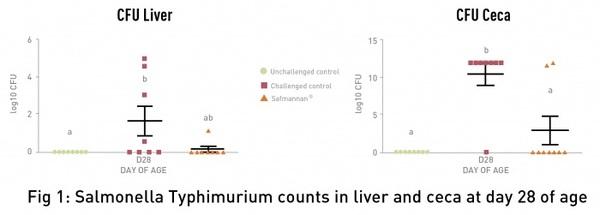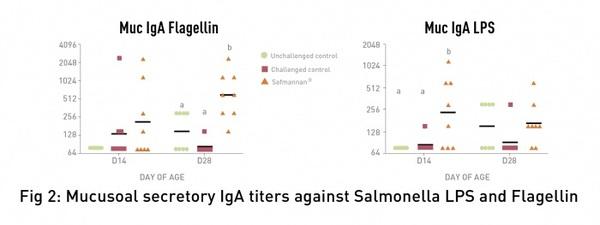
Content sponsored by:
Phileo by Lesaffre
Prevent Salmonella from undermining food safety
Published: December 16, 2020
By: Ruth Raspoet, PhD, Poultry R&D manager

Despite successful Salmonella control measures implemented in food-animal production, salmonellosis remains one of the most frequently occurring food-borne zoonoses worldwide, with poultry and poultry products as the main transmission vector. In general, about 65% of the animals belonging to a flock are identified as asymptomatic carriers and are colonized by Salmonella spp. Serotypes colonizing the gastrointestinal tract are variable, depending on the geographical location, time of the year, but part of them are repeatable e.g. Salmonella Enteritidis and Typhimurium. Moreover, the occurrence of antimicrobial resistance in non-typhoidal Salmonella is considered an additional major public health concern. Consequently, with the increasing consumption of poultry products, new intervention strategies are necessary along the food chain to reduce Salmonella prevalence during poultry production.
In the poultry industry, eggs and egg products can become contaminated through vertical transmission of the bacteria through the reproductive tract or horizontally on the eggshell when passing the cloaca or after contact with feces. Meat on the other hand, most often, becomes infected during the production process when bacteria of the intestine are contaminating the carcass as a result. Therefore, and since the gastrointestinal tract of food-producing animals is the main reservoir of non-typhoidal Salmonella, reduced colonization of this organ by the bacterial species is of outmost importance.
In this context yeast probiotics and postbiotics are playing a crucial role in animal health industry, as they can contribute to the reduction of antibiotics use while improving animal health and maintaining their productive potential. Yeast fractions are rich in mannoproteins, mannans and β-glucans, enabling them to modulate the gut physiology, microflora composition and the immune system.
Therefore, a study was carried out to evaluate the effect of the supplementation of Safmannan®, high-quality selected yeast postbiotic, on Salmonella Typhimurium colonization in broilers.
At day 1 of the trial, newly hatched broiler chicks were divided over 3 isolators, each representing one treatment group; the unchallenged control (UC), the challenged control (CC) and Safmannan® supplemented and challenged group. At day 2, animals in the challenged control and the Safmannan® group were orally inoculated with 108 CFU of Salmonella Typhimurium ATCC 14028. Individual body weights were recorded at days 3, 7, 14 and 28. Immune parameters, histology scores and Salmonella Typhimurium loads in liver and ceca were determined at day 28.
Challenge with Salmonella Typhimurium reduced body weights in the challenged control group early after challenge, while this reduction in performance was adverted by supplementation of Safmannan® into the diet of the challenged animals (Table.1).

Additionally, the challenged control exhibited significantly increased Salmonella Typhimurium numbers in liver and caecum compared to the negative control group, which remained negative for Salmonella throughout the experiment. Safmannan® was able to decrease the colonization of Salmonella Typhimurium in the liver (Fig. 1a) and ceca (Fig.1b) of broilers, while decreasing the lesion score in the cecum at 28 days of age.

The results also demonstrated the effect of Safmannan® on the mucosal immune system, since supplemented birds were able to produce higher antibody titers of IgA against Salmonella LPS and flagellin (Fig.2).

The effects of Safmannan® can be explained by the occurrence of β-glucans which allows them to modulate the immune system, while the presence of mannans can associate them with bacteria possessing type-1 fimbriae, such as Salmonella, making it more difficult for them to colonize the intestinal epithelium.
Microflora analysis of a previously performed nutritional stress study with administration of Safmannan®, showed that the supplemented animals had a microbiota composition exhibiting a higher diversity. Significant increases in beneficial genera such as, Roseburia, Ruminococcus torques, Eubacterium hallii and Shuttleworthia were observed. As an inhabitant of the healthy animal intestine, Ruminococcus torques probably increased its prevalence in the supplemented animals due to its capacity to convert/metabolise complex polysaccharides into nutrients that are beneficial for the host. Additionally, species belonging to the genus Eubacterium hallii and Roseburia are known to be able to interact with the acetate and lactate to produce butyric and propionic acid which have the capacity to strengthen the epithelial barrier function and positively impact the microbiota by reducing the pathogenic species. The latter was demonstrated by a decrease in the number of Enterobacteriaceae in the animals supplemented with Safmannan®.
In conclusion it can be confirmed that Safmannan® is able to modulate the microbiota and the immune system and in turn decrease the outcomes of Salmonella Typhymurium infections in broilers, leading to less colonization of the gastrointestinal tract and thus also carcass contamination during the production process.
Related topics:
Authors:
Phileo by Lesaffre
Recommend
Comment
Share
Scientific Veterinary Institute Novi Sad - Serbia
14 de julio de 2021
Nice work, thank you for your presentation.
Recommend
Reply
Opta Alimentos e Insumos
12 de julio de 2021
Dear Ruth, congratulations for the nice work. Microbiota modulation seems to be new sunrise of knowledge to go further on field perfomance and safety food.
Have you seens some reduction or increment on Lactobacilae numbers, and how was the diverstiy?
Cordially,
Recommend
Reply
27 de julio de 2021
Dear Ruth,
I do appreciate your findings to combat Salmonella infection in poultry firm because the same emerges to be a menace to cause human threat at the end. The indirect device to contain the spread through incorporating probiotic . Albeit it is not that conspicuous to note that group with probiotic does not reveal significant improvement in body weight gain even after 28;days while comparing with mean growth achieved by the group challenged with Salmonella but without any probiotics. Hence my request is to conduct another trial if required to project the true significance of probiotic in question under challenged state of firm first.
Dr.R.P. Chakraborty
Recommend
Reply
19 de diciembre de 2020
What about the ideal conc from each b glucagon and m o s in any product described for treatment salmonella?
Recommend
Reply
17 de diciembre de 2020
Nice work. The yeast metabolites play a very important role in enhancing gut immunity in poultry. Specially the beta glucans and mannanoligosaccharides in yeast cell wall. Some good products are also in the market like Hilysis from ICC Brazil.
Recommend
Reply

Would you like to discuss another topic? Create a new post to engage with experts in the community.





.jpg&w=3840&q=75)